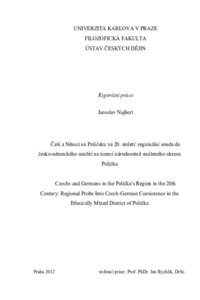Češi a Němci na Poličsku ve 20. století: regionální sonda do česko-německého soužití na území národnostně smíšeného okresu Polička
Czechs and Germans in the Polička's Region in the 20th Century: Regional Probe Into Czech-German Coexistence in the Ethnically Mixed District of Polička
rigorózní práce (UZNÁNO)

Zobrazit/
Trvalý odkaz
http://hdl.handle.net/20.500.11956/45345Identifikátory
SIS: 120887
Katalog UK: 990014600300106986
Kolekce
- Kvalifikační práce [24011]
Autor
Vedoucí práce
Fakulta / součást
Filozofická fakulta
Obor
Historie
Katedra / ústav / klinika
Ústav českých dějin
Datum obhajoby
20. 2. 2012
Nakladatel
Univerzita Karlova, Filozofická fakultaJazyk
Čeština
Známka
Uznáno
Klíčová slova (česky)
Česko-německé soužití, Hraničáři, Hřebečsko, menšinová politika, Mnichovská krize, národnostní boj, odsun Němců, okres Polička, regionální dějiny, Sudetoněmecké hnutíKlíčová slova (anglicky)
Czech-German koexistence, Bordermen, District of Polička, German lingual island Hřebečsko, Munich crisis, Minority policy, National confrontation, Transfer od Germans, Regional history, Sudetengerman movementRigorózní práce metodou regionální sondy mapuje vývoj vztahů mezi českou majoritou a německou minoritou na území bývalého politického okresu Polička. Těžiště popisu je v letech 1897-1946, pro pozdější dobu se výklad přesouvá zejména do oblasti vzpomínkové kultury a rozdílné interpretace společných dějin. Autor se snaží postihnout faktory, které ovlivňovaly postoje a jednání obyvatel v klíčových politických momentech let 1918, 1938 a 1945. Zaměřuje se nejen na každodenní kontakty obou národností, ale i na okolnosti a průběh tzv. národnostního boje.
Using a method of regional probing, the thesis seeks to map the evolution of relations between the Czech majority and the German minority that resided in the former political district of Policka. The analysis concentrates on the period of 1897-1946, with a concentration focusing on the culture of remembering and the ways in which both ethnic groups came to divergent interpretations of their mutually-shared history. The author strives to identify the factors that influneced the actions and positions of the local populace during the key political events of 1918, 1938 and 1945. He concentrates not only on the everday interactions between both ethnic groups, but also on the conditions that both groups found themelves in during the so-called national confrontation.
